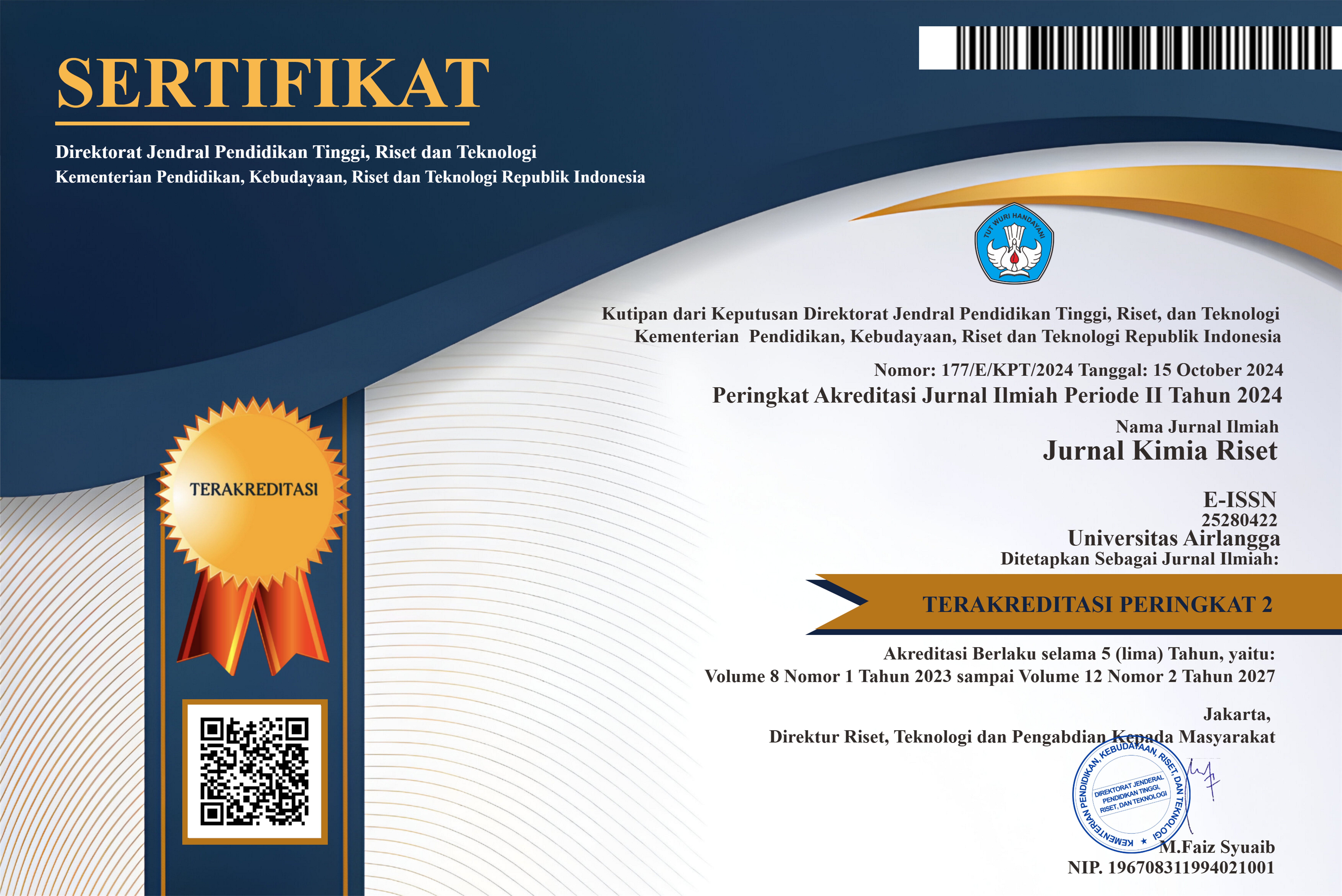Degradation of Humic Acids in Peat Water Using Fe3O4 Synthesized from Zircon Sand Tailing as Photo-Fenton Catalyst
Downloads
Zircon sand mining in Indonesia generates magnetic waste rich in magnetite (Fe₃O₄), which has semiconductor properties, making it an effective catalyst for degrading organic pollutants. This study explores the synthesis and application of Fe₃O₄ derived from zircon mining waste as a photo-Fenton catalyst for humic acid (HA) degradation in peat water. The Fe₃O₄ catalyst was synthesized using a co-precipitation method, confirmed by FTIR and XRD analyses. FTIR identified Fe–O bonds at 537 cm-1 and 419 cm-1, while XRD showed a spinel crystal structure with peaks at 2θ angles of 30.14°, 35.51°, 43.19°, and 56.96°. The catalytic activity was tested under UV light with varying H₂O₂ volumes and Fe₃O₄ masses. The optimized condition, using 0.03 g Fe₃O₄ and 1 mL H₂O₂, achieved a maximum HA degradation efficiency of 87.06% in 100 minutes. Kinetic analysis revealed second-order kinetics, with a rate constant (k) of 8.29 × 10-4 M-1.min-1 and R² = 0.9911, showing a strong correlation. The high efficiency is attributed to Fe₃O₄'s semiconductor properties, which facilitate hydroxyl radical formation and enhance electron transfer. These findings demonstrate the potential of Fe₃O₄ from zircon mining waste as a sustainable catalyst for environmental applications, particularly in treating organic pollutants in peat water.
Agnestisia, R., 2017. Synthesis & Characterization of Magnetit (Fe3O4) and Its Applications As Adsorbent Methylene Blue. Jurnal Sains dan Terapan Kimia, 11(2), p.61.
Andayani, W. and Bagyo, A.N.M., 2011. TiO2 BEADS FOR PHOTOCATALYTIC DEGRADATION OF HUMIC ACID IN PEAT WATER. Indonesian Journal of Chemistry, 11(3), p.253.
Ayunda, S.R., Zainul, R., Oktavia, B. and Putra, A., 2022. Degradasi Asam Humat Dengan Katalis TiO2/N Menggunakan Cahaya Matahari. Jurnal Periodic Jurusan Kimia UNP, 11(2), p.84.
Beladona, S.U.M., Putra, R., Alfanaar, R., Sylvani, M.M., Alyatikah, E., Safitri, R., Susanti, I. and Iqbal, R.M., 2023. A Review: Development of Photocatalyst Materials and Its Performance for Humic Acid Removal in Peatwater. Journal of Peat Science and Innovation, 1(1), pp.1–15.
Blanco-Gutiérrez, V., Li, P., Berzal-Cabetas, R. and Dos santos-García, A.J., 2022. Exploring the photocatalytic activity of nanometric magnetite for PET materials degradation under UV light. Journal of Solid State Chemistry, 316, p.123509.
Budi, H., Husain, H., Supanun, L. and Suminar, P., 2019. Examination of Natural and Standard Fe3O4 Powders Using X-Ray Absorption Near-Edge Spectroscopy (XANES). Materials Science Forum, 964, pp.40–44.
Darminto, Cholishoh, M.N., Perdana, F.A., Baqiya, M.A., Mashuri, Cahyono, Y., Triwikantoro, Iskandar, F. and Abdullah, M., 2011. Preparing Fe3O4 Nanoparticles from Fe2+ Ions Source by Co-precipitation Process in Various pH. 2011 pp. 234–237.
Gadgeel, A.A., Mhaske, S.T., Duerr, C. and Liu, K.L., 2019. In-Situ Preparation and Characterization of Aconitic Acid Capped Fe3O4 Nanoparticle by Using Citric Acid as a Reducing Agent. Journal of Inorganic and Organometallic Polymers and Materials, 29(5), pp.1688–1700.
Gediga, J., Morfino, A., Finkbeiner, M., Schulz, M. and Harlow, K., 2019. Life cycle assessment of zircon sand. The International Journal of Life Cycle Assessment, 24(11), pp.1976–1984.
Herrera-Pérez, J.G., Legorreta-García, F., Reyes-Pérez, M., Reyes-Cruz, V.E., Chávez-Urbiola, E.A. and Trujillo-Villanueva, L.E., 2023. Analysis of the Effect of Magnetic Separation Processing Parameters for the Treatment of Mining Waste. Polish Journal of Environmental Studies.
Husain, S., Irfansyah, M., Haryanti, N.H., Suryajaya, S., Arjo, S. and Maddu, A., 2019. Synthesis and characterization of Fe3O4 magnetic nanoparticles from iron ore. Journal of Physics: Conference Series, 1242(1), p.012021.
Khader, E.H., Muslim, S.A., Saady, N.M.C., Ali, N.S., Salih, I.K., Mohammed, T.J., Albayati, T.M. and Zendehboudi, S., 2024. Recent advances in photocatalytic advanced oxidation processes for organic compound degradation: A review. Desalination and Water Treatment, 318, p.100384.
Khan, Z.U.H., Gul, N.S., Sabahat, S., Sun, J., Tahir, K., Shah, N.S., Muhammad, N., Rahim, A., Imran, M., Iqbal, J., Khan, T.M., Khasim, S., Farooq, U. and Wu, J., 2023. Removal of organic pollutants through hydroxyl radical-based advanced oxidation processes. Ecotoxicology and Environmental Safety, 267, p.115564.
Khuzaima, N., Ahmad, K.R., Ahmad Zaidi, N.H., Hashim, M.K.R. and Rezan, S.A., 2018. Minerals Characterization of Magnetic and Non-Magnetic Element from Black Sand Langkawi. Solid State Phenomena, 280, pp.440–447.
Liu, Y., Zhao, Y. and Wang, J., 2021. Fenton/Fenton-like processes with in-situ production of hydrogen peroxide/hydroxyl radical for degradation of emerging contaminants: Advances and prospects. Journal of Hazardous Materials, 404, p.124191.
Loures, C.C.A., Alcântara, M.A.K., Filho, H.J.I., Teixeira, A.C.S.C., Silva, F.T., Paiva, T.C.B. and Samanamud, G.R.L., 2013. Advanced Oxidative Degradation Processes: Fundamentals and Applications. International Review of Chemical Engineering (IRECHE), 5(2), p.102.
Mahmud, N., Benamor, A., Nasser, M.S., Ba-Abbad, M.M., El-Naas, M.H. and Mohammad, A.W., 2021. Effective Heterogeneous Fenton-Like degradation of Malachite Green Dye Using the Core-Shell Fe3O4@SiO2 Nano-Catalyst. ChemistrySelect, 6(4), pp.865–875.
Maulinda, Zein, I. and Jalil, Z., 2019. Identification of Magnetite Material (Fe3O4) Based on Natural Materials as Catalyst for Industrial Raw Material Application. Journal of Physics: Conference Series, 1232(1), p.012054.
Murtadho, I., Muslih, E.Y. and Kusuma, D.Y., 2022. Zirconia content enrichment of Indonesian zircon sand by using alkali fusion followed by water leaching and sulfuric acid leaching. 2022 p. 030006.
Napoleao, D.C., Zaida, L.E.M.C., Rodríguez-Díaz, J.M., Santana, R.M. da R., Montenegro, M.C.B. da S. de M., Araújo, A. da N., Benachour, M. and Silva, V.L. da, 2018. Use of the photo-Fenton process to discover the degradation of drugs present in water from the Wastewater Treatment Plants of the pharmaceutical industry. Journal of Chemical Engineering Theoretical and Applied Chemistry, 75(581).
Nengsih, S., Nur Abdulmadjid, S., Mursal, M. and Jalil, Z., 2024. Photocatalytic performance of Fe3O4-TiO2 in the degradation of methylene blue dye: Optimizing the usability of natural iron sand. Materials Science for Energy Technologies, 7, pp.374–380.
Nugroho, B.S., Asri, A. and Arman, Y., 2023. Exploring TiO2-PP as a Reusable Floating Photocatalyst for Humic Acid and Iron Removal in Peat Water. INDONESIAN JOURNAL OF APPLIED PHYSICS, 13(2), p.171.
Pasaribu, M.H., Karelius, K., Agnestisia, R., Toepak, E.P. and Pereiz, Z., 2024. Potential Of Magnetite (Fe₃O₄) Synthesized From Zircon Sand Waste As Methylen Blue Dye Adsorbent. Jurnal Inovasi Teknik Kimia, 9(2), pp.98–107.
Qadafi, M., Wulan, D.R., Notodarmojo, S. and Zevi, Y., 2023. Characteristics and treatment methods for peat water as clean water sources: A mini review. Water Cycle, 4, pp.60–69.
Ramos, R.O., Albuquerque, M.V.C., Lopes, W.S., Sousa, J.T. and Leite, V.D., 2020. Degradation of indigo carmine by photo-Fenton, Fenton, H2O2/UV-C and direct UV-C: Comparison of pathways, products and kinetics. Journal of Water Process Engineering, 37(May), p.101535.
Saragi, T., Permana, B., Saputri, M., Safriani, L., Rahayu, I. and Risdiana, 2018. Karakteristik Optik dan Kristal Nanopartikel Magnetit. Jurnal Ilmu dan Inovasi Fisika, 2(1), pp.53–56.
Sativa, S.O., Zulfikar, M.A., Suryandari, E.T. and Nasir, M., 2021. Effect of Composite Composition in Nanofiber for Degradation of Humic Acid Solution. Advanced Materials Research, 1162, pp.87–92.
Setiadi, E.A., Sebayang, P., Ginting, M., Sari, A.Y., Kurniawan, C., Saragih, C.S. and Simamora, P., 2016. The synthesization of Fe3O4 magnetic nanoparticles based on natural iron sand by co-precipitation method for the used of the adsorption of Cu and Pb ions. Journal of Physics: Conference Series, 776, p.012020.
Song, W., Cheng, M., Ma, J., Ma, W., Chen, C. and Zhao, J., 2006. Decomposition of Hydrogen Peroxide Driven by Photochemical Cycling of Iron Species in Clay. Environmental Science & Technology, 40(15), pp.4782–4787.
Sun, T. et al., 2024. Visible-light-driven photo-Fenton oxidation enhanced by Fe/Bi-nanocrystal phase transformation as a universal way for various organic pollutants mineralization. Chemical Engineering Journal, 481, p.148732.
Suseno, T., 2015. Analisis prospek pasir zirkon Indonesia di pasar dunia. Jurnal Teknologi Mineral dan Batubara, 11(1), pp.61–77.
Takeuchi, N., Ando, M. and Yasuoka, K., 2015. Investigation of the loss mechanisms of hydroxyl radicals in the decomposition of organic compounds using plasma generated over water. Japanese Journal of Applied Physics, 54(11), p.116201.
Villegas, A.R., Ramírez, V.I.D.L., Guevara, J.H., Sicairos, E.P., Ayala, S.A.H., Sanchez, L.L. and Bertha, 2020. Synthesis and characterization of magnetite nanoparticles for photocatalysis of nitrobenzene. Journal of Saudi Chemical Society, 24(2), pp.223–235.
Wang, Z., Jia, X., Sun, W., Wang, J., Li, C., Zhao, Q., Li, Y. and Tian, S., 2023. Persulfate-based remediation of organic-contaminated soil: Insight into the impacts of natural iron ions and humic acids with complexation/redox functionality. Science of The Total Environment, 905, p.167177.
Wardhani, S., Mardiansyah, H.A. and Purwonugroho, D., 2023. Fe3O4-SiO2-Alginate Photocatalyst for Textile Dyes Waste Degradation. Science and Technology Indonesia, 8(1), pp.108–115.
Wu, Y., Zhou, S., Qin, F., Zheng, K. and Ye, X., 2010. Modeling the oxidation kinetics of Fenton’s process on the degradation of humic acid. Journal of Hazardous Materials, 179(1–3), pp.533–539.
Yuan, C., Chin, Y.-P. and Weavers, L.K., 2018. Photochemical acetochlor degradation induced by hydroxyl radical in Fe-amended wetland waters: Impact of pH and dissolved organic matter. Water Research, 132, pp.52–60.
Zhou, W., Gao, J., Zhao, H., Meng, X. and Wu, S., 2017. The role of quinone cycle in Fe2+ – H2O2 system in the regeneration of Fe2+. Environmental Technology, 38(15), pp.1887–1896.
Zulkarnaini, A., Sanjaya, H., Yohandri, Y. and Nizar, U.K., 2022. Degradasi Asam Humat Pada Air Rawa Gambut menggunakan Metode Fotosonolisis dengan Bantuan Katalis ZnO. Jurnal Periodic Jurusan Kimia UNP, 11(1), p.35.
Copyright (c) 2025 Jurnal Kimia Riset

This work is licensed under a Creative Commons Attribution-NonCommercial-ShareAlike 4.0 International License.
COPYRIGHT NOTICE
1. By submitting the article to Jurnal Kimia Riset (JKR), the author has agreed to transfer some of the copyrights to the publisher of the research chemistry journal, Universitas Airlangga, indicated in the Copyright Transfer Agreement.
2. Authors still retain significant rights to use and share their own published articles for non-commercial purposes subject to Creative Commons Attribution-NonComercial 4.0 International License
3. All publications (printed/electronic) are open access for educational purposes, research, library, and other non-commercial purposes. Besides the purposes mentioned above, the editorial board is not responsible for copyright violations.















